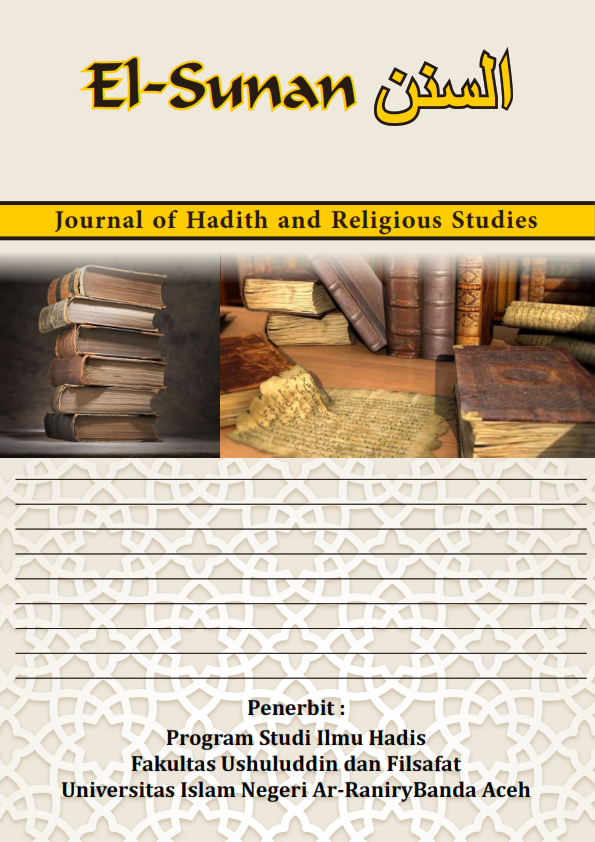Analyzing Hadith Sanad Validity: Steps to Assess Acceptance and Authenticity
Abstract
Hadith does not possess the same textual certainty (qath'i al-wurud) and argument certainty (qath'i al-dalalah) as the Qur'an. Therefore, the discipline of hadith science was developed to ensure the authenticity of hadith through sanad (chain of transmission) and matan (content) criticism. Sanad criticism focuses on tracing the origin of hadith based on its narrators, while matan criticism evaluates the content of the text. This article aims to identify and verify the quality and authenticity of hadith by conducting an in-depth analysis of the sanad and matan. By exploring the characteristics and credibility of the narrators and the integrity of their transmission chain, the study distinguishes between sahih, hasan, and dha'if hadith based on authenticity and content relevance. Through the science of Takhrij al-Hadith, this research demonstrates that the validation of hadith authenticity is an essential and ongoing effort to preserve and understand the authentic teachings of Islam. The study also emphasizes the importance of Jarh wa Ta’dil in determining the fairness and precision of narrators, as well as investigating shudhudh (inconsistencies) and 'illat (hidden defects) in hadith.
References
Al-Absi, Hamada R H, Devi G Kurup, Amina Daoud, Jens Schneider, Wajdi Zaghouani, Saeed Mohd H M Al Marri, and others, ‘Al-Ahadeeth: A Visualization Tool of the Hadiths’ Chain of Narrators BT - HCI International 2024 Posters’, ed. by Constantine Stephanidis, Margherita Antona, Stavroula Ntoa, and Gavriel Salvendy (Cham: Springer Nature Switzerland, 2024), pp. 3–8
Al-Adlabi, Salahuddin ibn Ahmad, Metodologi Kritik Matan Hadits,Terj. Qadirun Nur Dan Ahmad Musyfiq (Jakarta: Gaya Media Pratama, 2004)
Amin, Kamaruddin, Menguji Kembali Keakuratan Metode Kritik Hadits (Jakarta: Hikmah, 2009)
Hasjim Abbas, Kritik Matan Hadits: Versi Muhaditsin Dan Fuqaha (Yogyakarta: Teras, 2004)
Imtyas, Rizkiyatul, Ahmad Hasyim, and Muhammad Helmi, ‘Methods of Contemporary Sanad Hadith Criticism: (Study on The Understanding Perspective of Middle Eastern Hadith Scholars)’, in Proceedings of the 4th International Colloquium on Interdisciplinary Islamic Studies in Conjunction with the 1st International Conference on Education, Science, Technology, Indonesian and Islamic Studies, ICIIS and ICESTIIS 2021, 20-21 October 2021, Jambi (EAI, 2022) <https://doi.org/10.4108/eai.20-10-2021.2316330>
Ismail, Nurjannah, and Encang Sarip Hidayat, ‘Takhrij Hadits: Pemahaman, Metode, Dan Tujuan’, El-Sunan: Journal of Hadith and Religious Studies, 1.2 (2023), 101–12 <https://doi.org/10.22373/el-sunan.v1i2.4113>
Khoiruddin, Irvan Ahmat, ‘HISTORISITAS SANAD DALAM PERSPEKTIF ILMU HADITS: Otentitas Sanad Di Mata Pendukung Dan Pengkritiknya’, Jurnal El-Hikam, 16.2 (2023), 198–222 <https://ejournal.iainh.ac.id/index.php/elhikam/article/view/388>
Maihula, Jabir Sani, and Muhammad Mujtaba Abdulkadir, ‘In-Depth Analysis on the Methodology of Sanad and MatanCriticisms: The Perspective of Hadith Scholars’, IAR Journal of Humanities and Social Science, 3.01 (2022), 55–60 <https://doi.org/10.47310/iarjhss.2022.v03i01.008>
Munawarsyah, ‘Sejarah Resmi Kodifikasi Hadits Nabi Muhammad SAW Sebagai Sumber Hukum Islam’, UNIVERSAL GRACE JOURNAL, 1.1 (2023), 13–20 <https://ejurnal.ypcb.or.id/index.php/ugc/article/view/8>
Rahman, Andi, ‘Pengenalan Atas Takhrij Hadis’, Riwayah : Jurnal Studi Hadis, 2.1 (2017), 146 <https://doi.org/10.21043/riwayah.v2i1.1617>
Ridho Ilahi, Muhammad Barnaba, Fahrur Razi, Afif Maulana, and Babun Najib, ‘Hadith Critics Categories in The Selection of Hadith Narrators: A Comparative Analysis’, Jurnal Ilmiah Al-Mu’ashirah, 20.2 (2023), 266 <https://doi.org/10.22373/jim.v20i2.16787>
Shukur, Zarina, Norasikin Fabil, Juhana Salim, and Shahrul Azman Noah, ‘Visualization of the Hadith Chain of Narrators BT - Visual Informatics: Sustaining Research and Innovations’, ed. by Halimah Badioze Zaman, Peter Robinson, Maria Petrou, Patrick Olivier, Timothy K Shih, Sergio Velastin, and others (Berlin, Heidelberg: Springer Berlin Heidelberg, 2011), pp. 340–47
Wasman, Wasman, Mesraini Mesraini, and Suwendi Suwendi, ‘A Critical Approach to Prophetic Traditions: Contextual Criticism in Understanding Hadith’, Al-Jami’ah: Journal of Islamic Studies, 61.1 (2023), 1–17 <https://doi.org/10.14421/ajis.2023.611.1-17>
Copyright (c) 2024 Nuraini Nuraini

This work is licensed under a Creative Commons Attribution-NonCommercial-ShareAlike 4.0 International License.
- Authors retain copyright and grant the journal right of first publication with the work simultaneously licensed under an Attribution-NonCommercial-ShareAlike 4.0 International (CC BY-NC-SA 4.0) that allows others to share the work with an acknowledgment of the work's authorship and initial publication in this journal.
- Authors are able to enter into separate, additional contractual arrangements for the non-exclusive distribution of the journal's published version of the work (e.g., post it to an institutional repository or publish it in a book), with an acknowledgment of its initial publication in this journal.
- Authors are permitted and encouraged to post their work online (e.g., in institutional repositories or on their website) prior to and during the submission process, as it can lead to productive exchanges, as well as earlier and greater citation of published work.












.png)




